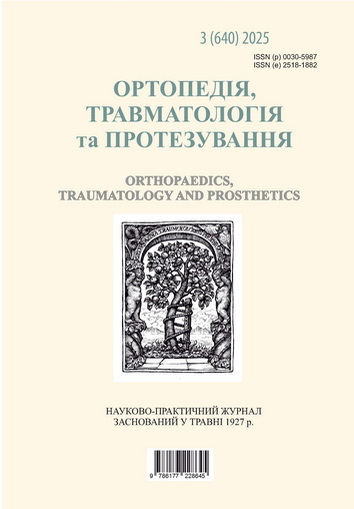ANALYSIS OF RISK FACTORS AND ASSESSMENT OF PREVENTION OF VENOUS THROMBOEMBOLIC COMPLICATIONS IN PATIENTS WITH HIP JOINT REPLACEMENT
DOI:
https://doi.org/10.15674/0030-59872025361-67Keywords:
Arthroplasty, idiopathic coxarthrosis, risk factors, thromboembolic complications, antithrombin-III, thrombotic preventionAbstract
The issue of thromboembolic complications prevention is one of great importance, since patients have a high risk of developing postoperative venous thromboembolism. Objective. To analyze risk factors contributing to the development of venous thromboembolic complications in patients with hip pathology undergoing arthroplasty, and to substantiate its prophylactic measures. Methods. Depending on age, all patients were divided into groups: 20–40 years — 13 individuals, 41–60 years — 13 individuals, 61– 80 years — 42 cases. To assess the effectiveness of thromboprophylaxis, two groups of patients diagnosed with stage III–IV idiopathic coxarthrosis aged 41 to 80 years were compared. 100 patients with various pathologies of the hip who underwent surgical treatment with endoprosthetics were involved. Results. Among the identified nosological forms of pathology, idiopathic coxarthrosis was most frequently diagnosed in patients aged 41 to 80 years. Our study demonstrated dynamic changes in the hemostatic system in patients after total hip arthroplasty when using various drugs for the prevention of thromboembolic complications, taking into account the level of antithrombin-III. In patients of the group I who received nadroparin calcium, the fibrinogen content in the blood before the operation was 4.90 (4.50–5.10) g/l, after 7 days — 4.40 (4.30–4.65), after 14 — 3.54 (2.30–3.75) g/l. In group II, thromboprophylaxis was achieved by taking dabigatran etexilate, before the operation, the fibrinogen content in the blood was 4.87 (4.45–5.15) g/l, after 7 days — 4.30 (4.20–4.50), after 14 — 3.62 (2.35–3.80) g/l. Conclusions. In patients with hip pathology, the main risk factors for venous thromboembolic complications before the endoprosthetic surgery and in the early postoperative period are age 41-80 years, obesity, arterial hypertension, as well as chronic venous insufficiency of the lower extremities. Thromboprophylaxis in total hip arthroplasty should be implemented with an individualized approach, considering not only surgical factors but also the early postoperative period.
Downloads
How to Cite
Issue
Section
License
Copyright (c) 2025 Stanislav Bondarenko, Oleksandr Vysotskyi

This work is licensed under a Creative Commons Attribution 4.0 International License.
The authors retain the right of authorship of their manuscript and pass the journal the right of the first publication of this article, which automatically become available from the date of publication under the terms of Creative Commons Attribution License, which allows others to freely distribute the published manuscript with mandatory linking to authors of the original research and the first publication of this one in this journal.
Authors have the right to enter into a separate supplemental agreement on the additional non-exclusive distribution of manuscript in the form in which it was published by the journal (i.e. to put work in electronic storage of an institution or publish as a part of the book) while maintaining the reference to the first publication of the manuscript in this journal.
The editorial policy of the journal allows authors and encourages manuscript accommodation online (i.e. in storage of an institution or on the personal websites) as before submission of the manuscript to the editorial office, and during its editorial processing because it contributes to productive scientific discussion and positively affects the efficiency and dynamics of the published manuscript citation (see The Effect of Open Access).














